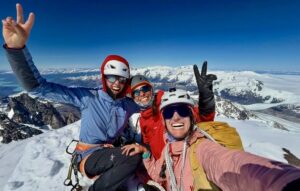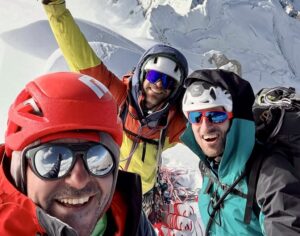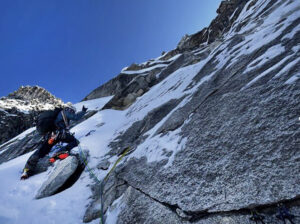John Michael Magness, a 58-year-old U.S. Army veteran, died on Aconcagua last weekend, likely from Acute Mountain Sickness. Ois Oystein, 62, of Norway suffered the same fate just 24 hours earlier. The deaths have left some wondering whether climbers or outfitters are underestimating this highest peak in the Americas.
Altitude, not accidents
The two casualties this weekend occurred within hours. Neither was a climbing accident.
Magness felt sick on the upper part of the mountain, during the summit push. He retreated and received some first aid and oxygen at the Refugio Independencia Hut (6,380m). His guide then helped him down to Nido de Condores — the normal route’s Camp 2 at 5,550m. There, Magness died, TN reported. Hailing from Texas, Magness was an ex-fighter pilot turned entrepreneur, La Nacion wrote.

John Michael Magness. Photo: La Nacion
On Saturday, Oystein suddenly collapsed near La Cueva (the cave) at 6,700m. His climbing partners tried to revive him with CPR but were unsuccessful, according to local media.
Two serious falls
In addition, others have been severely injured this season. Two climbers, one from France and another from the UK, took serious falls on January 21 and 24. Both accidents occurred at approximately the same spot above Nido de Condores, the normal route’s Camp 2, at 5,550m. The French climber’s injuries included a broken skull, while the Briton, a 32-year-old member of Nirmal Purja’s Elite Expedition team, ultimately had one of his legs amputated.
One other American climber was evacuated with cerebral edema during the season, according to local media.

File image of the place where the British climber fell and ended up losing his leg. A French climber fell three days earlier, from a point slightly below. Photo: Acomara Aconcagua Expedition
Local guide’s report
Fernando Jadur, CEO at Acomara Aconcagua Expeditions, shared some details about the incidents with ExplorersWeb. The two injured climbers injured fell at the spot known as La Travesía, a short but exposed section at around 6,550m. In some seasons, as in the file photo above, conditions are straightforward. This year, the hard snow required crampons and an ice ax. A fall on slippery snow on that steep slope could run as long as 800m.
The deceased climbers began to feel badly quite high up on the mountain, around La Canaleta, the couloir leading to the summit area.

Aconcagua’s normal northwest route. Photo: Acomara Aconcagua Expeditions
Rescue is not the problem
Speaking about the last weekend’s casualties, Marcos Paez, head of the rescue patrol, told TN Argentina that there are two medical stations in the Aconcagua area, including one at 4,300m. But neither of the sick climbers made it down there.
“Patrolers sometimes climb to the upper slopes and advise climbers who are feeling badly to turn around,” he said. Paez notes that an increasing number of exhausted, sick climbers continue toward the summit, despite how they feel.
There is also a good helicopter rescue service in the area, but it too has its limits. Pilots can land at three established points, the highest of them being the Nido de Condores at 5,550m. They also fly only in daylight and if weather permits.
Fernando Jadur of Acomara Aconcagua Expeditions — the biggest local outfitter, with 25 years of experience and no casualties so far — wonders: How many of the deaths and accidents could have been avoided if climbers and outfitters had followed basic safety protocols?

Two climbers on El Filo del Guanaco (Guanaco’s Ridge), slightly above the site where the Norwegian climber collapsed, near the summit. Photo: shot last year by Acomara Aconcagua Expeditions
“The events trigger many unanswered questions,” Jadur told ExplorersWeb. “Were the guiding teams adequate? Familiar with the terrain, properly credited? Were there enough guides?”
Don’t underestimate Aconcagua
Jadur points out that Aconcagua’s normal route requires no rock or ice climbing skills. There is very little fixed rope, except for a couple of exposed passages. Yet the role of the guide is paramount.
“It is not just about showing the way,” Jadur says. “Guides must know the terrain perfectly, but they must also make sure they have their group controlled and accompanied. They need to be aware of their clients’ strengths and weaknesses, check their condition constantly, and be ready to react the moment they perceive that something is not right.
“Otherwise,” he adds, “it is like offering a drive in a car without safety belts or airbags. Sure, the car can take you to your destination and you’ll get there okay, as long as nothing happens. The difference comes when something actually happens.”
Acomara had groups on the mountain throughout the season, including when the accidents took place. One of their teams, comprising 10 clients and six guides, helped in one of the rescue attempts because they were closer to the sick climber than the patrols.
Jadur declined to comment about teams other than his own. “Of course, there is no such thing as total safety in high-altitude mountaineering. There is also a luck factor on every climb, but we must help good luck as much as we can.”
A 7,000m mountain

Aconcagua. Photo: Acomara
Expedition operators usually tag Aconcagua as a great introduction to high altitude for beginners, including those preparing for their first 8,000m experience and/or engaged in the Seven Summits challenge. Supplementary oxygen is rare on Aconcagua, despite its remarkable height. At 6,961m, it is the tallest peak in the Americas.
The climb usually takes two weeks. Outfitters schedule some extra days in case of bad weather or conditions. Yet some climbers or teams try to finish in as few days as possible.
Despite its technical ease, Aconcagua is a very high mountain, subject to objective dangers and abrupt changes in weather. Most importantly, it needs proper acclimatization before a summit push.
Tough conditions
Conditions have been far from perfect this season. Garrett Madison describes tricky snow/ice conditions during his company’s recent climb as a possible reason for the falls at the Travesía. One of Madison’s guides was, by the way, Ed Viesturs, the first U.S. 14×8,000m summiter. According to the new list from 8000ers.com, Viesturs was actually the first to climb all 14. He did so without supplementary O2.
Furtenbach Adventures also had teams on the mountain starting in December and witnessed the changes in conditions.
“The snow came in January, and it was most welcome after the very dry conditions of last season,” Lukas Furtenbach said.

Climbers on the Polish Glacier head toward the summit of Aconcagua. Photo: Pablo Betancourt/Furtenbach Adventures
Jadur confirmed that the January snowstorm delayed some groups and made the climb harder. “Yet except during the storms, it was not bad,” he said. “It is also noteworthy that climbing Aconcagua is much easier to climb now than 20 years ago, thanks to better rescue and logistics.”






